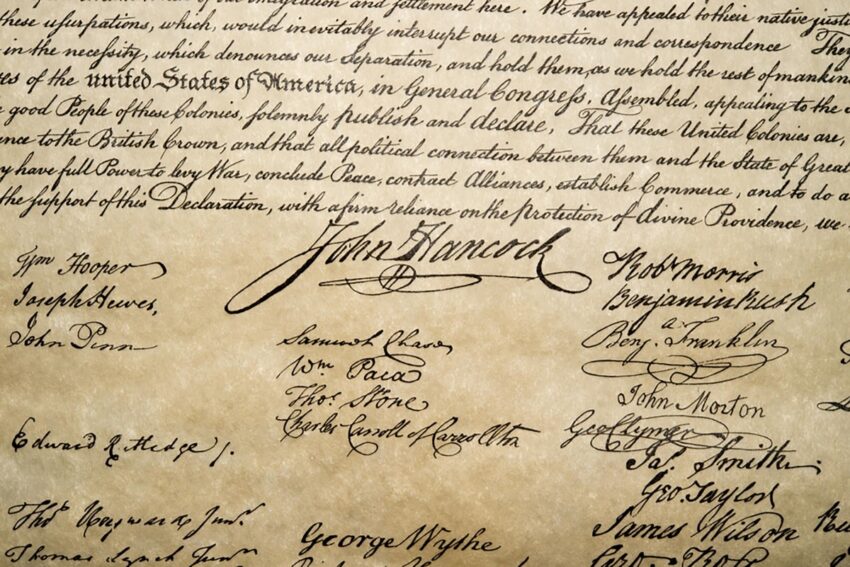The most famous signature in American history belongs to John Hancock, whose bold, flamboyant script on the Declaration of Independence gave birth to an enduring American expression. Today, when Americans say “put your John Hancock on it,” they mean simply “sign here”—but the story behind this linguistic legacy reveals both the character of the man and the gravity of the moment that created it.
The Man Behind The Signature
Born on January 23, 1737, in Braintree, Massachusetts, John Hancock was no ordinary colonist. After his father’s death in 1744, he was raised by his wealthy uncle Thomas Hancock, a successful Boston merchant. This privileged upbringing afforded him an education at Harvard College, from which he graduated in 1754 at age 17. Upon his uncle’s death in 1764, Hancock inherited a large estate, becoming one of the wealthiest men in the colonies.
By the time he arrived at the Second Continental Congress, Hancock was already a marked man. Along with Samuel Adams, he was one of the two most wanted men in the colonies by King George III. His wealth, influence, and vocal opposition to British policies—including his support for boycotts against British imports—had made him a prime target of the Crown.
The Moment Of Signing
As President of the Second Continental Congress, Hancock held a position of unique prominence when the Declaration of Independence was adopted on July 4, 1776. While popular mythology suggests all delegates signed on that date, historical records indicate that the formal signing ceremony primarily took place on August 2, 1776.
Hancock, however, did sign on July 4—along with Secretary Charles Thomson—to authenticate the original document. As President of Congress, he presumably signed first on the formal parchment copy, setting the tone for all who would follow.
The Signature Itself
Hancock’s signature on the Declaration is nearly 5 inches (13 cm) long, dramatically larger than those of his fellow signers. The size and flourish of his signature were no accident. According to legend, Hancock proudly declared, “There! I guess King George will be able to read that!” Another account suggests he commented that the British ministry could “read that name without spectacles.”

Whether these exact words were spoken or embellished by history, they capture the defiant spirit of the moment. In an era when signing the Declaration was considered an act of treason punishable by death, Hancock’s bold signature was itself an act of courage and defiance.
From Signature To Symbol
The transformation of “John Hancock” into a synonym for signature didn’t happen overnight. The phrase emerged in American vernacular over the decades following independence, as copies and reproductions of the Declaration circulated widely. The visual impact of Hancock’s signature—so prominently larger than all others—made it the most memorable element of the document for many Americans.
By the 19th century, “John Hancock” had become firmly established in American English as a colloquial term for one’s signature. The expression embodied both the physical act of signing and the courage required to put one’s name to one’s convictions.
The Price Of Prominence
Hancock’s willingness to make his signature so prominent came with real risks. As mentioned in Benjamin Rush’s 1811 letter to John Adams, the signing was conducted in “pensive and awful silence,” with delegates understanding they might be signing their own death warrants. The gallows humor of the moment was captured when the rotund Benjamin Harrison reportedly told the diminutive Elbridge Gerry that he would have “a great advantage” when they were hanged, as Harrison would “die in a few minutes” while Gerry would “dance in the air an hour or two.”
Hancock continued to serve the revolutionary cause after signing, acting as a major general during the Revolutionary War and later serving as Governor of Massachusetts from 1780-1785 and again from 1787 until his death in 1793.
An Enduring Legacy
Today, John Hancock’s signature represents more than just a historical curiosity. It embodies the American spirit of boldness, the willingness to stand behind one’s convictions, and the courage to make oneself known even in the face of danger. When Americans use the phrase “put your John Hancock here,” they invoke not just the memory of a signature, but the legacy of a man who was willing to risk everything for the cause of independence.
The fact that this 18th-century politician’s name became synonymous with the very act of signing documents speaks to the power of that singular moment in Independence Hall. In making his signature impossible to miss, John Hancock ensured that his name—and the courage it represented—would be remembered for generations to come.
From a wealthy Boston merchant to a wanted revolutionary, from President of Congress to American icon, John Hancock’s journey reminds us that sometimes the boldest gestures create the most lasting impressions. His signature, meant as an act of defiance against a king, instead became an eternal symbol of American independence and individual conviction—proof that sometimes, size really does matter.
Thanks for reading!
